
Introduction
Over the last year or so there's been a steady
influx of new displays offering a super-high resolution. The new wave of "4k"
displays sporting 3840 x 2160 resolutions, 4 times that of traditional 1920
x 1080 HD content has begun to flood the market, with various options available
and most manufacturers now producing some kind of 4k offering. In January we tested
our first 4k screen in the form of
Dell's UP3214Q, a premium grade screen with a lot of high end features and a
price tag to match. In fact a lot of the early 4k resolution displays came at a
very high cost. A little later, 4k resolutions started to be introduced in
smaller displays, and in many cases at very affordable prices. A new batch of
28" sized screens hit the market, sporting this 4k resolution and also offering
some impressive specs to try and attract the gaming market. Expensive, high-end
panels like that used in the Dell were dropped in favour of lower cost TN Film
matrices, helping to make 4k more affordable to the masses.
We've got one of these 28" 4k models with us now
for review. Samsung's U28D590D is one of the better spec'd offerings in this
space, boasting a 1ms G2G response time and also the all-important support for
60Hz refresh rates when using the 3840 x 2160 resolution over DisplayPort. It is
also detected as a single display, as opposed to being a Multi-Stream detection
as we'd experienced with the UP3214Q (explained more in that review). Some other
competing models are limited to 30Hz refresh rate due to the relatively new
usage of such a high resolution. Fine for day to day uses, but certainly
limiting when it comes to games and dynamic content. Thankfully the Samsung
offering can run at the full 60Hz refresh rate.
If you appreciate the review
and enjoy reading and like our work, we would welcome a
donation
to the site to help us continue to make quality and detailed reviews for you.

Support TFTCentral,
buy the Samsung U28D590D using our affiliate link

Specifications and Features
The following table gives detailed information
about the specs of the screen:
|
Monitor
Specifications |
|
Size |
28"WS (71.12cm) |
Panel Coating |
Moderate AG coating |
|
Aspect Ratio |
16:9 |
Interfaces |
DisplayPort 1.2, 2x HDMI 1.4 |
|
Resolution |
3840 x 2160 |
|
Pixel Pitch |
0.16 mm |
Design
colour |
Glossy black bezel and matte silver base |
|
Response Time |
1ms G2G |
Ergonomics |
Tilt only |
|
Static Contrast Ratio |
1000:1 |
|
Dynamic Contrast Ratio |
'Mega' |
VESA Compatible |
No |
|
Brightness |
370 |
Accessories |
Power, HDMI, DisplayPort cables. External
power brick |
|
Viewing Angles |
170/160 |
|
Panel Technology |
Innolux TN
Film |
Weight |
With stand: 5.65Kg |
|
Backlight Technology |
W-LED |
Physical Dimensions |
(WxHxD) with stand
660.9 x 486.3 x 169.4 mm |
|
Colour Depth |
1.07b |
|
Refresh Rate |
60Hz |
Special
Features |
PiP
and PbP |
|
Colour Gamut |
Standard gamut ~sRGB |
The U28D590D offers a somewhat limited range of connectivity options. There are
only DisplayPort and 2x HDMI interfaces provided for video
connections. There is no DVI or D-sub offered here. The DisplayPort 1.2
connection can support for the full 3840 x 2160 resolution at 60Hz refresh rate,
while the HDMI 1.4 ports can only support the native res at 30Hz. It's nice to
see HDMI provided for connection of external devices, consoles etc. Even if they
don't support the 4k resolution the screen can upscale the image on the nice
large 28" sized screen. Cables are provided in the box for both HDMI (x1) and
DisplayPort which is good.
The screen has an external power supply so there
is an external power brick supplied in the box. There are no extras really on
this screen and it is lacking things like USB ports, speakers, ambient light
sensors etc. It supports Picture in Picture (PiP) and Picture by Picture (PbP)
modes when using multiple inputs.
Below is a summary of the features and connections
of the screen:
|
Feature |
Yes / No |
Feature |
Yes / No |
|
Tilt adjust |
 |
DVI |
 |
|
Height adjust |
 |
HDMI |
 |
|
Swivel adjust |
 |
D-sub |
 |
|
Rotate adjust |
 |
DisplayPort |
 |
|
VESA compliant |
 |
Component |
 |
|
USB 2.0 Ports |
 |
Composite |
 |
|
USB 3.0 Ports |
 |
Audio connection |
 |
|
Card Reader |
 |
HDCP Support |
 |
|
Ambient Light Sensor |
 |
MHL Support |
 |
|
Human Motion Sensor |
 |
Integrated Speakers |
 |
|
Touch Screen |
 |
PiP / PbP |
 |
|
Hardware calibration |
 |
Blur Reduction Mode |
 |
|
Uniformity correction |
 |
G-Sync |
 |

Design and Ergonomics
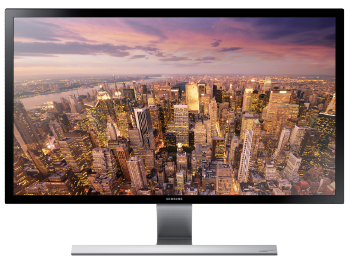
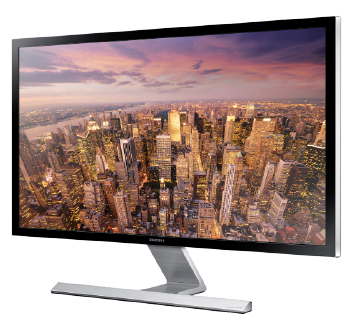
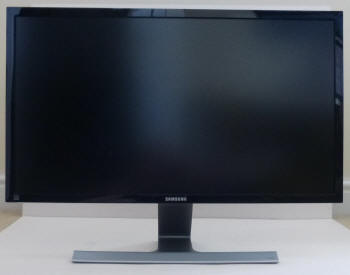
Above:
front views of the screen. Click for larger versions
The U28D590D comes in a mostly black design,
with glossy plastics used for the bezel. The bezel itself is nice and thin
measuring ~16mm along all edges. There is a Samsung logo in the middle of
the lower bezel but no other markings on the front at all. There is a
silver coloured trim around the sides of the screen which gives a nice
finish and contrast to the glossy black plastics.
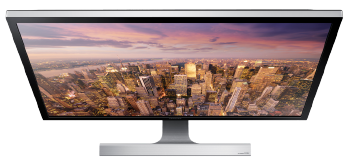
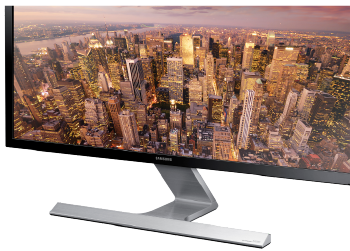
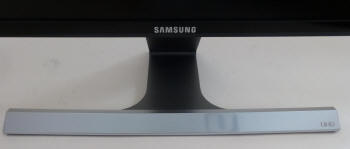
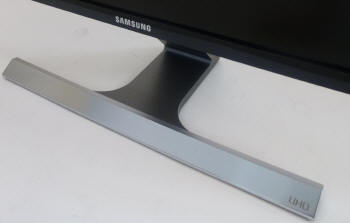
Above: views of the stand and base. Click for larger versions
The back of the screen has a small
protruding stand attachment at the bottom which slots easily into the base
of the stand. This is a matte silver coloured T-shape stand as shown
above. It looks pretty nice.
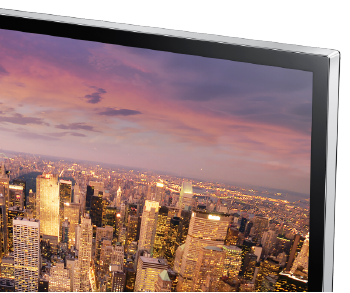
Above: view of silver side trim. Click for larger version
The silver trim around the edges of the
screen is shown above.
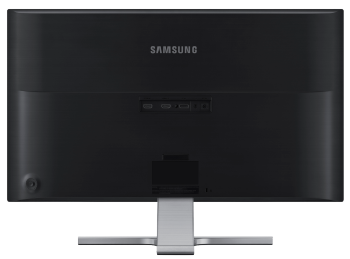
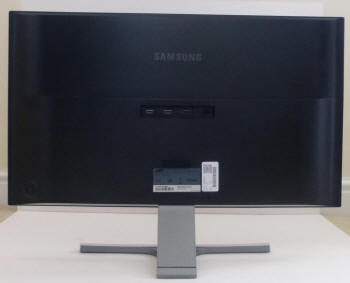
Above: rear views of the screen. Click for larger versions
The back of the screen is finished in a
matte black plastic, with a brushed appearance. There is a larger Samsung logo
at the top, and the connection ports are in the middle of the back as you can
see above. It should be noted that there is no VESA mounting option here at
all. There are also no screws anywhere, so it feels like a nicely enclosed
display.
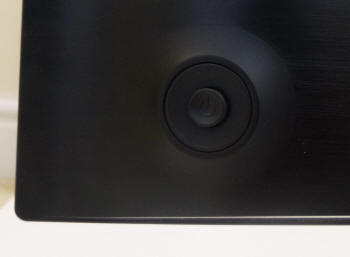
Above: joystick controller on the back of the screen. Click for larger
version
The back bottom left corner (as
viewed from behind) features a small joystick controller for accessing the
OSD menu.
There is a small power LED on the front of the screen in the bottom right hand
corner. This glows blue during operation and blinks on/off in blue when in
standby.
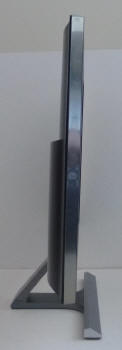
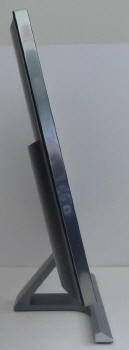
Above: side views showing maximum tilt adjustment range. Click for larger
versions
The stand offers a limited range
of ergonomic options with only a basic tilt adjustment offered. This is smooth
to move but very stiff, and the screen is unstable and wobbly as you make the
adjustments as well. It would have been nice to see height and swivel
adjustments included as well, sadly they are missed here. The screen is not
VESA compliant either so cannot be wall- or arm-mounted. You are stuck with
the fairly limited stand we're afraid. For reference, the screens bottom edge
is ~100mm from the edge of the desk when vertical.
A summary of the screens ergonomic adjustments
is shown below:
|
Function |
Range |
Smoothness |
Ease of Use |
|
Tilt |
Yes |
Smooth |
Very Stiff |
|
Height |
n/a |
- |
- |
|
Swivel |
n/a |
- |
- |
|
Rotate |
n/a |
- |
- |
|
Overall |
Limited adjustments with only
tilt available which is stiff to use and makes the screen wobbly. |
The materials were of a very good standard and
build quality felt sturdy and strong. There was
no audible buzzing noise from the screen even when conducting specific
tests which can often identify buzzing issues.
The whole screen remained very cool even during prolonged use as well which
was pleasing.
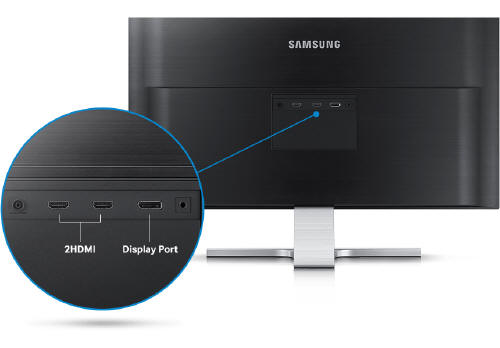
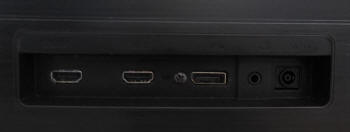
Above: rear view of connections. Click for larger versions
The back of the screen in the middle area features the video connections for DisplayPort
and 2x HDMI. There is also connection for audio output (when sending sound to
the screen as well), and the external power supply.

OSD Menu

Above: joystick controller on the back of the screen. Click for larger
version
The OSD menu is accessed and controlled through a
single joystick controller located on the back right hand edge of the screen as
you look at it from the front. This joystick is pressable as well and controls
the whole menu.
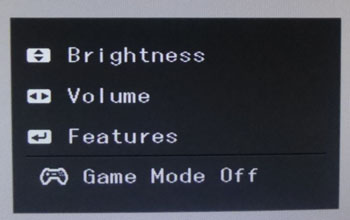
Moving the joystick in any direction gives you
quick access to a couple of features. When you move it, the menu above pops
up. If you then press up/down on the joystick you get quick access to the
brightness, and also from there quick access to contrast and sharpness. The
menu changes to the following:

Pressing the joystick right/left brings up quick
access to the volume control as shown below if you're using the audio out
connection on the scren:

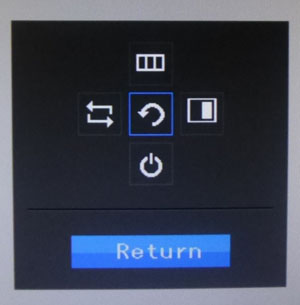
Pressing the button in brings up access to the
main menu. You can go up to access the main OSD, left to choose the screen
input, right for PiP/PbP options and down to power the screen off. There's no
power on/off button as such, it's a function of the OSD menu.
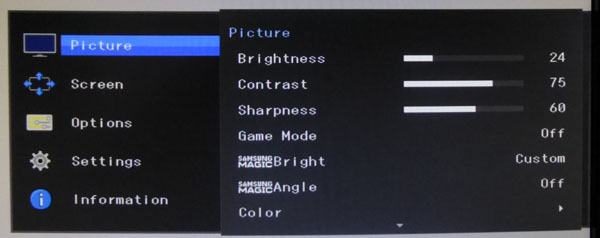
If you go into the main OSD menu it is split
into 5 sections down the left hand side. If you then move right on the
joystick you can enter the section you are currently highlighted on and the
menu options move over as shown below.
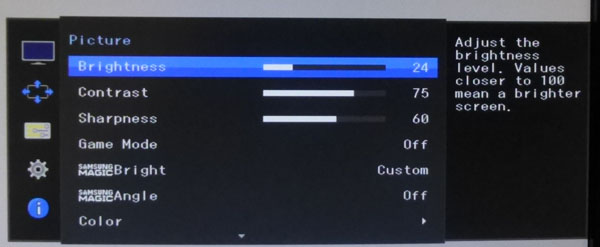
In the picture menu there are controls for
brightness, contrast and sharpness. The "game mode" is a preset specifically
designed for gaming. You can access the MagicBright preset modes here as well:
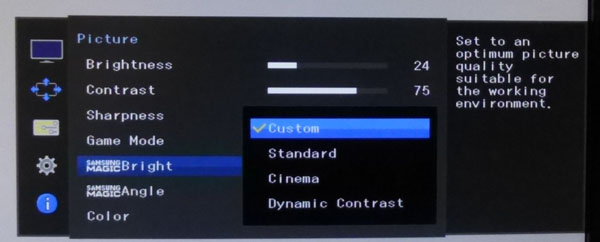
You can also adjust the color settings from this
section which gives you control over the RGB levels as shown below:
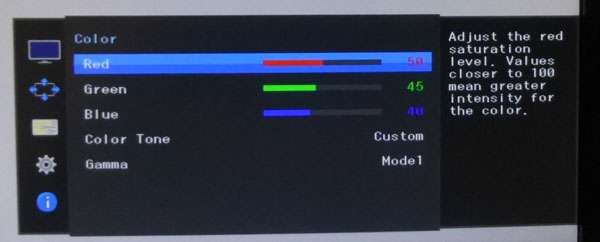
There is also access to control the response
time setting here:
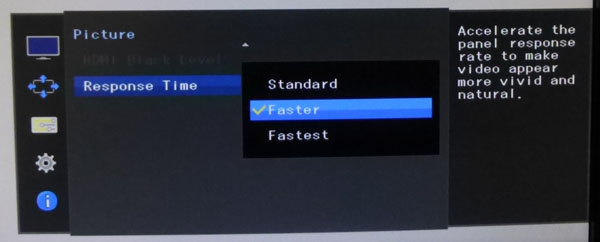
The 'screen' section of the menu allows you to
control the aspect ratio option (wide or auto) and also the PiP and PbP
settings:
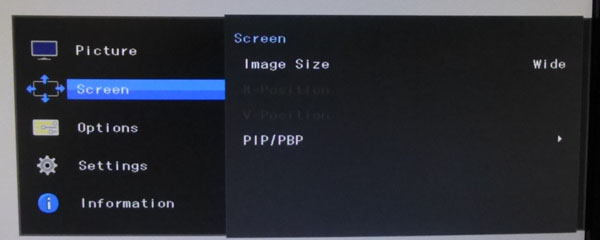
The options section is pretty self-explanatory:
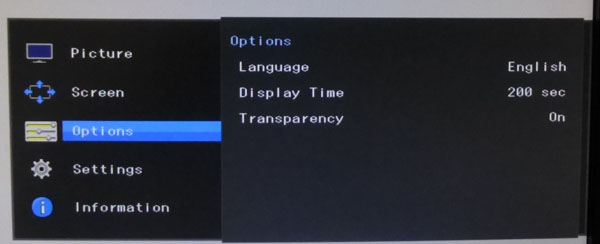
In the 'settings' section there are a few more
things to play with:
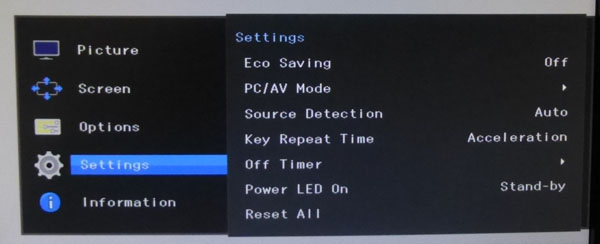
Finally, the 'information' section confirms your
resolution and refresh rate:
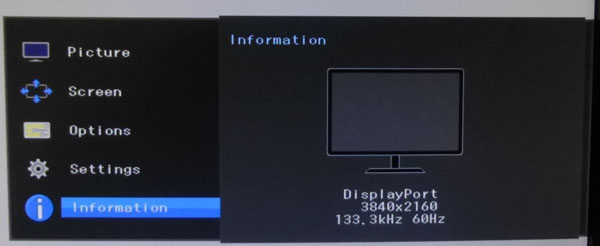
All in all, navigation was pretty simple via the
joystick controller, and there were a decent range of options to play with.
Sometimes you had to drill through several layers of menu but all in all it
was pretty good. The software was quite low res and looked big though,
certainly compared with the sharpness and res of the panel.

Power Consumption
In terms of power consumption the manufacturer
lists 32.0W usage in the "Energy Star test condition" and 0.3W in standby. We carried out our normal tests to
establish its power consumption ourselves.
|
 |
|
State and Brightness
Setting |
Manufacturer Spec (W) |
Measured Power Usage
(W) |
|
Default (100%) |
32.0 |
39.3 |
|
Calibrated (24%) |
- |
23.2 |
|
Maximum Brightness (100%) |
- |
39.3 |
|
Minimum Brightness (0%) |
- |
17.0 |
|
Standby |
0.3 |
0.5 |
|
We tested this ourselves and found that out of the
box the screen used 39.3W at the default 100% brightness setting. Once calibrated the screen reached 23.2W consumption, and in standby it
used only 0.5W. We have plotted these results below compared with other screens
we have tested. The consumption is very comparable to other W-LED backlit
displays, with wide gamut GB-r-LED units like the ViewSonic VP2772 using
slightly more (comparing calibrated states).


Panel and Backlighting
|
Panel Manufacturer |
Innolux |
Colour Palette |
1.07b |
|
Panel Technology |
TN Film |
Colour Depth |
10-bit |
|
Panel Module |
M280DGJ-L30 (Rev C1) |
Colour space |
sRGB, standard gamut |
|
Backlighting Type |
W-LED |
Colour space coverage (%) |
sRGB, 72% NTSC |
Panel Part and Colour Depth
The Samsung U28D590D utilises a
Innolux (previously Chi Mei Optoelectronics / Chi Mei Innolux) M280DGJ-L30
TN Film panel which is
capable of producing 1.07 billion colours. This is achieved apparently through a
10-bit grey scale and the detailed panel spec sheet does not mention the use of Frame Rate Control (FRC).
Keep in mind whether this is practically useable and whether you're ever going
to truly use that colour depth. You need to have a full 10-bit end to end
workflow to take advantage of it which is still quite expensive to achieve and
rare in the market, certainly for your average user. This includes relevant
applications and graphics cards as well, so to many people this 10-bit support
might be irrelevant.
The panel is confirmed when dismantling the screen
as shown:
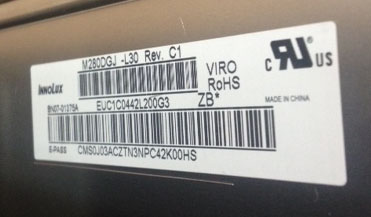
Screen
Coating
The
screen coating on the U28D590D is a a medium anti-glare (AG) offering. It
isn't a semi-glossy coating, and isn't as light as some modern IPS type panels
either. It's in keeping with other TN Film panels we've tested. Thankfully it
isn't a heavily grainy coating like some old IPS panels feature, although there
is some graininess noticeable sometimes. It retains its anti-glare properties to
avoid too many unwanted reflections of a full glossy coating, but does not
produce an too grainy or dirty an image that some thicker AG coatings can. There
were no cross-hatching patterns visible on the coating
Backlight Type and Colour Gamut
The screen uses a White-LED (W-LED) backlight unit
which has become very popular in today's market. This helps reduce power
consumption compared with older CCFL backlight units and brings about some
environmental benefits as well. The W-LED unit offers a standard colour gamut
which is approximately equal to the sRGB colour space.
Anyone wanting to work with wider colour spaces would need to consider wide
gamut CCFL screens, or perhaps the newer range of GB-r-LED displays available
now. If
you want to read more about colour spaces and gamut then please have a read of
our
detailed article.
Backlight
Dimming and Flicker
We tested the screen to establish the methods used
to control backlight dimming. Our in depth article talks in more details about a
common method used for this which is called
Pulse Width Modulation (PWM). This in itself gives cause for concern to some
users who have experienced eye strain, headaches and other symptoms as a result
of the flickering backlight caused by this technology. We use a photosensor +
oscilloscope system to measure backlight dimming control
with a high level of accuracy and ease. These tests allow us to establish
1) Whether PWM is being used to control the
backlight
2) The frequency and other characteristics at which this operates, if it is used
3) Whether a flicker may be introduced or potentially noticeable at certain
settings
If PWM is used for backlight dimming, the higher
the frequency, the less likely you are to see artefacts and flicker. The duty
cycle (the time for which the backlight is on) is also important and the shorter
the duty cycle, the more potential there is that you may see flicker. The other
factor which can influence flicker is the amplitude of the PWM, measuring the
difference in brightness output between the 'on' and 'off' states. Please
remember that not every user would notice a flicker from a backlight using PWM,
but it is something to be wary of. It is also a hard thing to quantify as it is
very subjective when talking about whether a user may or may not experience the
side effects.
100%
50%


31%
30%
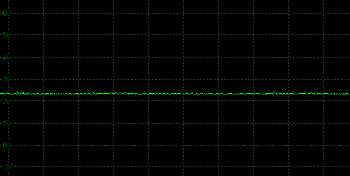
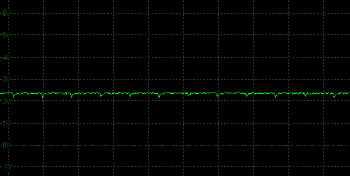
20%
0%
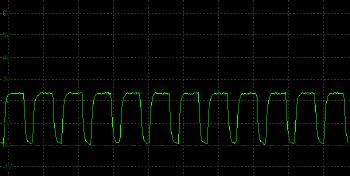

Above scale = 1
horizontal grid = 1ms
At 100% brightness a constant voltage is applied
to the backlight and there is no need for any kind of PWM regulation as normal
for most screens. As you begin to lower the brightness setting a Direct Current
(DC) method is used initially, as opposed to any kind of Pulse Width Modulation
(PWM). As a result, there is no oscillation or PWM off/on backlight flickering.
This applies for all settings between 100% and 31% brightness. From 30% and
below a PWM technique is used for backlight dimming, where the duty cycle (on
time) gets progressively shorter as you lower the brightness setting. This
operates at a frequency of 240 Hz which is pretty low, and so may present
problems to users sensitive to the use of PWM and flickering backlights. If you
need to use the screen below 31% brightness setting (see our
following section)
this may be problematic to some.
|
Pulse Width
Modulation Used |
Hybrid
100 - 31% = no
30 - 0% = yes |
|
Cycling
Frequency |
100 - 31% = n/a
30 - 0% = 240Hz |
|
Possible
Flicker at |
|
|
100% Brightness |
No |
|
50% Brightness |
No |
|
30% Brightness |
Yes |
|
0% Brightness |
Yes |
For an up to date list of all flicker-free (PWM free) monitors please see our
Flicker Free Monitor Database.

Contrast
Stability and Brightness
We wanted to see how much variance there was in
the screens contrast as we adjusted the monitor setting for brightness.
In theory, brightness and contrast are two independent parameters, and good
contrast is a requirement regardless of the brightness adjustment.
Unfortunately, such is not always the case in practice. We recorded the
screens luminance and black depth at various OSD brightness settings, and
calculated the contrast ratio from there. Graphics card settings were left at
default with no ICC profile or calibration active. Tests were made using an
X-rite i1 Display Pro colorimeter. It should be noted that we used the
BasICColor calibration software here to record these, and so luminance at
default settings may vary a little from the LaCie Blue Eye Pro report.
|
OSD
Brightness |
Luminance
(cd/m2) |
Black
Point (cd/m2) |
Contrast
Ratio
( x:1) |
|
100 |
361.89 |
0.43 |
842 |
|
90 |
333.60 |
0.40 |
834 |
|
80 |
304.94 |
0.37 |
824 |
|
70 |
277.04 |
0.33 |
840 |
|
60 |
247.02 |
0.30 |
823 |
|
50 |
217.76 |
0.26 |
838 |
|
40 |
186.27 |
0.22 |
847 |
|
30 |
157.73 |
0.19 |
830 |
|
20 |
109.76 |
0.13 |
844 |
|
10 |
61.47 |
0.07 |
878 |
|
0 |
13.67 |
<0.02 |
- |
|
Total Luminance Adjustment Range
(cd/m2) |
348.22 |
Brightness OSD setting controls backlight? |
 |
|
Total Black Point
Adjustment Range (cd/m2) |
>0.36 |
|
Average Static Contrast Ratio |
840:1 |
PWM Free? |
Hybrid |
|
Recommended OSD setting
for 120 cd/m2 |
22 |
The brightness control gave us a very good range
of adjustment. At the top end the maximum luminance reached 362
cd/m2 which was
high, and only just shy of the specified maximum brightness of 370 cd/m2
from the manufacturer. There was a large 348 cd/m2 adjustment range
in total, and so at the minimum setting you could reach down to a very
low luminance of 14 cd/m2. This should certainly be adequate for
those wanting to work in darkened room conditions with low ambient light. A
setting of 22 in the OSD menu should return you a
luminance of around 120 cd/m2 at default settings.
It should be noted that the
brightness regulation is controlled without the need of
Pulse Width Modulation using a Direct Current (DC) method for settings
between 100 and 31% and so the screen
is flicker free at anything above 30%. Below that, a PWM method is used at a low
frequency of 240Hz, which may present problems to those sensitive to its use.
You can only get down to a luminance of only 158.4
cd/m2 before
you need to enter the PWM-zone so it's likely that this might present an
issue for a lot of users, as they will likely want to have the screen darker
than this and will therefore be within the PWM-zone.

We have plotted the
luminance trend on the graph above. The screen behaves as it should in this
regard, with a reduction in the luminance output of the screen controlled by the
reduction in the OSD brightness setting. This is a linear relationship between a
setting of 100 and 31, as you
can see from the line but from 30 - 0%, where the PWM usage kicks in, there is a
steeper curve where the brightness adjustments makes slightly more differences
to the luminance.

The average contrast ratio of
the screen was moderate for a TN Film panel with an average of 840:1. This was pretty stable across
the brightness adjustment range as shown above.

Testing
Methodology
An
important thing to consider for most users is how a screen will perform out of
the box and with some basic manual adjustments. Since most users won't have
access to hardware colorimeter tools, it is important to understand how the
screen is going to perform in terms of colour accuracy for the average user.
We restored our graphics card to default settings and disabled any previously active
ICC profiles and gamma corrections. The screen was tested at default factory settings using the DVI interface, and analysed using
an
X-rite i1
Pro Spectrophotometer (not to be confused with the i1 Display Pro
colorimeter) combined with
LaCie's Blue Eye Pro software suite. An X-rite i1 Display Pro colorimeter was
also used to verify the black point and contrast ratio since the i1 Pro
spectrophotometer is less
reliable at the darker end.
Targets for these tests are as follows:
-
CIE Diagram - validates the colour space
covered by the monitors backlighting in a 2D view, with the black triangle representing the
displays gamut, and other reference colour spaces shown for comparison
-
Gamma - we aim for 2.2 which is the default
for computer monitors
-
Colour temperature / white point - we aim
for 6500k which is the temperature of daylight
-
Luminance - we aim for 120
cd/m2, which is
the recommended luminance for LCD monitors in normal lighting conditions
-
Black depth - we aim
for as low as possible to maximise shadow detail and to offer us the best
contrast ratio
-
Contrast ratio - we aim
for as high as possible. Any dynamic contrast ratio controls are turned off here
if present
-
dE average / maximum -
as low as possible.
If DeltaE >3, the color displayed is significantly different from the
theoretical one, meaning that the difference will be perceptible to the
viewer.
If DeltaE <2, LaCie considers the calibration a success; there remains a
slight difference, but it is barely undetectable.
If DeltaE < 1, the color fidelity is excellent.

Default Performance and
Setup
Default settings of the screen were as follows:
|
Monitor OSD Option |
Default Settings |
|
Brightness |
100 |
|
Contrast |
75 |
|
Samsung MagicBright |
Custom |
|
RGB Gain |
50, 50, 50 |
|
Color Tone |
Normal |
|
Gamma |
Mode1 |

Samsung U28D590D - Default Factory Settings




|
|
Default Settings |
|
luminance (cd/m2) |
370 |
|
Black Point (cd/m2) |
0.44 |
|
Contrast Ratio |
842:1 |
Initially out of the box the screen was very
bright and was set at the maximum 100% brightness setting. Colour balance felt
good, and you could tell it was a standard gamut screen. The image felt a little
washed out but only slightly. We went ahead and measured the default state with
the i1 Pro.
The
CIE diagram on the left of the image confirms that the monitors colour gamut
(black triangle) is roughly equal to
the sRGB colour space. There is some over-coverage in some shades, with green
and blue
being a little wider than the sRGB space. Default gamma was recorded at 2.1 average, leaving it with a
small 6%
deviance from the target of 2.2 which was reasonable. In lighter grey shades the
gamma was further away from the target as you can see from the table below,
leading to some of the washed out appearance we noticed. White point was
measured at 6635k being close to the target of 6500k which was good and with
only a 2% deviance.

Luminance was recorded at a very bright 370
cd/m2 which is
far too high for prolonged general use. The screen was set at a default 100%
brightness in the OSD menu but that is easy to change of course to reach a more
comfortable setting. The black depth was 0.44 cd/m2 at this default
brightness setting, giving us a reasonable (for a TN Film panel) static contrast ratio of
842:1.
Colour accuracy was fairly good out of the box
with a default dE average of 2.6, and maximum of 5.9. Testing the screen with
various gradients showed smooth transitions with no sign of any banding
thankfully. There was some gradation evident as you will see from most monitors.
Overall the default setup was decent enough, with the gamma and white point
being reasonable. We would have perhaps hoped for a slightly higher contrast
ratio nearer to 1000:1 which some TN Film panels can achieve.

We also switched to the 'standard' preset mode
(MagicBright option) to test the default setup in that mode:
|
Monitor OSD Option |
Default Settings |
|
Brightness |
51 |
|
Contrast |
75 |
|
Samsung MagicBright |
Standard |
|
RGB Gain |
50, 50, 50 |
|
Color Tone |
Normal |
|
Gamma |
Mode1 |

Samsung U28D590D - Default Factory Settings, Standard mode
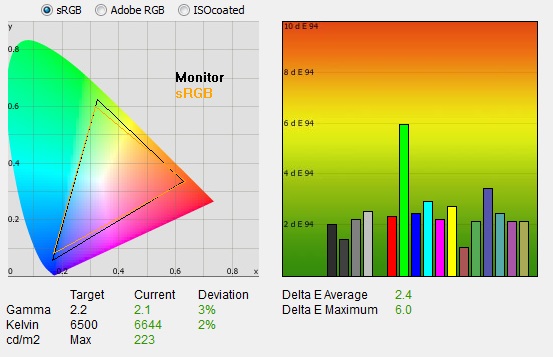
|
|
Default Settings,
Standard mode |
|
luminance (cd/m2) |
223 |
|
Black Point (cd/m2) |
0.26 |
|
Contrast Ratio |
853:1 |
When switching to the 'standard' MagicBright mode
there was an immediate drop in the luminance of the screen. Looking at the OSD
menu confirms the default brightness is now 51 instead of 100. This gave us a
more comfortable luminance of 233
cd/m2, although
still too bright for ongoing use. Other
aspects of the setup had also improved slightly with an improved gamma (now 3%
out), and slightly improved colour accuracy (dE average of 2.4). This might make
a better starting point for users not wishing to carry out more detailed
calibration of the screen. You can revert to the standard mode and then just
change the brightness to suit.


Colour Temperatures and Gamma
The U28D590D features a range of defined 'color
tone'
modes within the OSD menu as shown in the below screen shots. There are also 3
pre-defined gamma modes available to choose from. We measured the screen
with the X-rite i1 Pro spectrophotometer in each of these modes to establish
their colour temperature / white point. We also tested the gamma in each mode,
while color tone was left at the default "normal". All other settings were left at factory defaults and no
ICC profile was active. The results are recorded below:
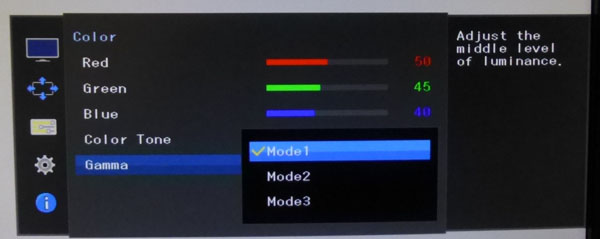
Gamma
|
Gamma Mode |
Average Gamma |
Deviance from
2.2 Gamma |
|
1 |
2.1 |
6% |
|
2 |
1.9 |
12% |
|
3 |
2.3 |
6% |
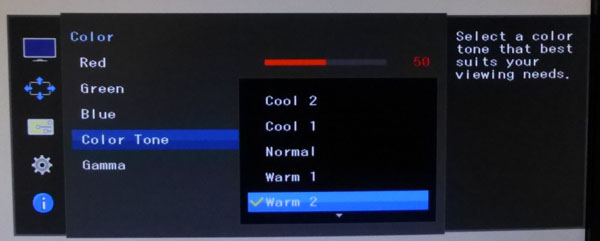
Colour Temperature
|
Color Tone
Mode |
Measured
White point (k) |
|
Cool 2 |
9925 |
|
Cool 1 |
8657 |
|
Normal |
6635 |
|
Warm 1 |
5854 |
|
Warm 2 |
5141 |
The gamma mode of 1 seemed to return a gamma
close enough to our target of 2.2, but being a little low at 2.1 average and
with a 6% deviance. Switching up to mode 3 was also only 6% out from the
target, but was now a bit too high at 2.3 average. None of the modes quite
matched the 2.2 level and so you will need to carry out some calibration if
you want to correct the gamma further. The normal color tone mode returned a
white point closest to the 6500k target which was only 2% out and a good
performance. The cool and warm modes acted correctly as they should.

Calibration
We used the
X-rite i1 Pro spectrophotometer combined with the LaCie Blue Eye Pro
software package to achieve these results and reports. An X-rite i1 Display Pro
colorimeter was used to validate the black depth and contrast
ratios due to lower end limitations of the i1 Pro device.
|
Monitor OSD Option |
Default Settings |
|
Brightness |
24 |
|
Contrast |
75 |
|
Samsung MagicBright |
Custom |
|
RGB Gain |
50, 45, 40 |
|
Color Tone |
Custom |
|
Gamma |
Mode1 |

Samsung U28D590D - Calibrated Settings

|
|
Calibrated Settings |
|
luminance (cd/m2) |
121 |
|
Black Point (cd/m2) |
0.15 |
|
Contrast Ratio |
797:1 |
We changed to the 'custom' MagicBright preset mode
which gives us full control over settings like the RGB levels. In changing the
RGB channels this moves you into the 'custom' color tone mode as well, since you
are moving away from any preset RGB values. We stuck with the default gamma mode
1 since we know this was about as close to the 2.2 gamma by default as possible. All these OSD
changes allowed us to obtain an
optimum hardware starting point and setup before software level changes would be
made at the graphics card level. We left the LaCie software to calibrate
to "max" brightness which would just retain the luminance of whatever brightness
we'd set the screen to, and would not in any way try and alter the luminance at
the graphics card level, which can reduce contrast ratio. These adjustments
before profiling the screen would help preserve tonal values and limit
banding issues. After this we let the software carry out the LUT adjustments and create an
ICC profile.

Average gamma was now corrected to 2.2 average,
correcting most of the 6% deviance we'd seen out of the box and only leaving it
with a minor 1% deviance now. The
decent white point was retained at 6499k, correcting the minor 2% deviance out
of the box. Luminance had been improved thanks to the adjustment to the
brightness control and was now being measured at 121
cd/m2. This
left us a black depth of 0.15 cd/m2 and maintained a reasonable static contrast ratio
(for a TN Film panel) of
797:1. Colour accuracy of the resulting
profile was very good, with dE average of 0.7 and maximum of 1.8. LaCie would
consider colour fidelity to be very good overall.
Testing the screen with various colour gradients
showed mostly smooth transitions. There was some slight gradation in darker tones
but no banding introduced due to the adjustments to the
graphics card LUT from the profilation of the screen which was pleasing.
You can use our settings and
try our calibrated ICC profile if you wish, which are available in
our ICC profile database. Keep in mind that results will vary from one
screen to another and from one computer / graphics card to another.

Calibration
Performance Comparisons

The comparisons made in this section try to give
you a better view of how each screen performs, particularly out of the box which
is what is going to matter to most consumers. When comparing the default factory
settings for each monitor it is important to take into account several
measurement areas - gamma, white point and colour accuracy. There's no point
having a low dE colour accuracy figure if the gamma curve is way off for
instance. A good factory calibration requires all 3 to be well set up. We have
deliberately not included luminance in this comparison since this is normally
far too high by default on every screen. However, that is very easily controlled
through the brightness setting (on most screens) and should not impact the other
areas being measured anyway. It is easy enough to obtain a suitable luminance
for your working conditions and individual preferences, but a reliable factory
setup in gamma, white point and colour accuracy is important and not as easy to
change accurately without a calibration tool.
From these comparisons we can also compare the
calibrated colour accuracy, black depth and contrast ratio. After a calibration
the gamma, white point and luminance should all be at their desired targets.

Default setup of the screen out of the box was
decent enough and gamma and white point were pretty close to their targets. It
is too bright of course, but that's easy to turn down via the brightness
setting.


The display was a little bit weak when it came to
black depth and contrast ratio. We would have liked a contrast ratio a bit
closer to 1000:1 for a modern TN Film panel although it was only slightly lower
than a lot of other recent models we'd tested to be fair (e.g. Asus PG278Q
858:1).

Support TFTCentral,
buy the Samsung U28D590D using our affiliate link

Viewing Angles

Above: Viewing
angles shown from front and side, and from above and below. Click for
larger image
Viewing angles of the U28D590D were as you might
expect from a TN Film panel. Unfortunately this panel technology is inherently
poor in this field, and so viewing angles are more restrictive than other
competing technologies like IPS, PLS and VA. Although the manufacturer will
quote a viewing angle of 170 / 160 (a classic indication that a TN Film panel is
being used by the way if in doubt), in practice there are some obvious contrast
and colour tone shifts horizontally, and especially vertically.
As you move your head from side to side in a
horizontal plane, there is a contrast shift and the image becomes lighter and
more washed out, and introduces a slight yellow hue. As you move to a wider
angle the image can become more washed out as well. Vertically the fields of
view are more restrictive still. From above the image becomes pale and washed
out, while from below there is a characteristic TN Film darkening of the image.
Unfortunately vertically the viewing angles will introduce noticeable shifts in
the contrast and colour tone of the image which mean that for any colour
critical work it is not really very well suited. TN Film panels have long
suffered from these restrictive viewing angles due to the nature of their pixel
structure. They are still fine for a single user for general use and certainly
the TN Film panels offer their advantages when it comes to pixel response times
and refresh rate for gaming. If however, you were hoping to do any colour
critical or photography work you may find these shifts in the appearance of the
image difficult. An IPS panel would probably be a wiser choice if you were
looking for a screen with much wider viewing angles. However, the use of a TN
Film panel here is really how manufacturers like Samsung have kept the cost of
these 28" 4k resolution screens down. You have to make some sacrifices if you
want a lower cost 4k screen at the moment.
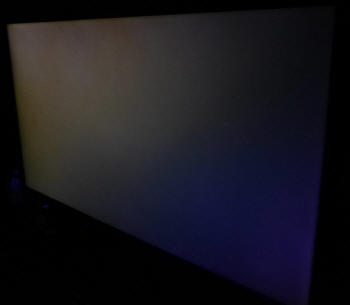
Above: View of an
all black screen from the side. Click for larger version
On a black image there is a pale grey tint
introduced to the image when viewed from a wide angle. This appears a little
yellow at the furthest points. This isn't too severe and shouldn't present any
real problems in practice. Certainly not the obvious white glow you get from
most modern IPS panels in similar situations and fairly standard for a TN Film
panel.

Panel Uniformity
We wanted to test
here how uniform the brightness and colour temperature was across the screen, as well as identify any
leakage from the backlight in dark lighting conditions. Measurements of the luminance
and colour temperature were taken at 35 points across the panel on a pure
white background. The measurements for luminance were taken using BasICColor's calibration
software package, combined with an X-rite i1 Display Pro
colorimeter with a central point on the screen calibrated to 120 cd/m2. Measurements for colour temperature (white point) were taken using
BasICColor software and the i1 Pro spectrophotometer which can more accurately
measure the white point of different backlighting technologies. The below uniformity diagram shows the difference, as a percentage,
between the measurement recorded at each point on the screen, as compared with the
central reference point.
It is worth
noting that panel uniformity can vary from one screen to another, and can depend
on manufacturing lines, screen transport and other local factors. This is only a
guide of the uniformity of the sample screen we have for review.

Uniformity of Luminance

The luminance uniformity of the screen was
moderate. The upper and lower parts of the
screen showed a fairly marked drop in luminance, down to a minimum of 94
cd/m2
(-27% deviance) which was significant. It was only the bottom most edge
where the maximum deviance was shown. The central areas of the screen were
more uniform compared with a centrally calibrated 120 cd/m2. For
colour critical work or viewing content with a lot of solid colour, this
variation across the panel would be problematic, but for normal uses and
things like gaming it didn't really cause any issue.

Backlight Leakage
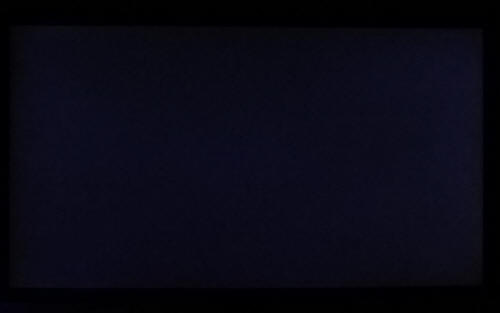
Above: All black screen in a darkened room. Click for larger version
As usual we also tested the screen with an all
black image and in a darkened room. A camera was used to capture the result.
There was no obvious backlight bleeding detectable to the naked eye at all. Some
slight clouding was evident along the left and right hand areas, but it was very
slight and hard to pick out in the photo above as well. No real issues here with
backlight bleed.

General and Office Applications
The U28D590 is an interesting way to offer a
massive 3840 x 2160 4k resolution while maintaining a reasonable cost for the
user. A lot of 4k res screens have been very expensive, but these new TN Film
panel models are more affordable, and making many people consider 4k as a
logical step in monitor evolution. You do need to keep in mind the need for a
compatible graphics card with a suitable output which can handle this
resolution, and preferably at 60Hz refresh rate. DisplayPort is the only option
to run the screen at its native 3840 x 2160 res at 60Hz, so is certainly
recommended. When running at native resolution this model is recognised as a
single display which makes life easier than some of the early MultiStream (MST)
4k models. It's also good to see support for 60Hz refresh rate as some competing
models only offer 30Hz support which is very limiting, even in day to day uses
(certainly for gaming!).
So how is this 4k resolution for office work? We
found the text size and pixel pitch a little too small when we tested the 31.5"
sized
Dell UP3214Q and so on this 28" sized screen it is even more of an issue.
Honestly we just found the text size far too small for any kind of office
work. Text is absolutely tiny with only a 0.16mm pixel pitch. Users need to be
aware of this we think, in an age of "retina displays" and the likes, bigger
resolution does not necessarily equal a better viewing experience. If you run
the screen at native resolution without any alterations to the picture settings,
be prepared for very tiny fonts and text! Obviously there are ways around this
like increasing the DPI setting in Windows. This serves to make fonts and texts
bigger, and then the added resolution of the panel provides crisp and sharp
images. However, not everything scales properly, and we found it a bit
troublesome with a lot of applications and formatting on websites. The other
option is to run the screen at a lower 2560 x 1440 resolution but then the image
has to be scaled and you lose a lot of the clarity and sharpness. It doesn't
look then as good as a native 2560 x 1440 panel. We remain unconvinced by the
practical usage of such high resolutions on desktop monitors for normal office
type uses. Cramming that same resolution into a 24" screen like the Dell UP2414Q
is surely going to be even more problematic?!
As a side note, we can of course see there is a
benefit in having a 4k resolution for some other uses. 4k video content, picture
viewing, and any work with particularly high resolution content will of course
benefit from the sharpness and resolution this panel can provide. Any games
which can support super high resolutions will also look excellent and with an
additional layer of detail offered by such a tight pixel pitch. In this section
though we are focusing on every day type uses and office work, and we just feel
users need to be aware of how a screen like this will look in real life.
The moderate AG coating of the TN Film panel is not a big issue and doesn't
produce any major graininess to the image like some aggressive AG solutions can.
It is however not semi-glossy or "light" so there is some graininess evident on
white backgrounds in office applications. The limited viewing angles of the TN
Film panel technology are perhaps the screens main weakness from a panel
technology point of view, meaning that you will notice colour and contrast
shifts if you deviate from a head on view of the screen. This may be problematic
if you are doing any colour work, or trying to view content from different
positions.
The default setup was decent enough with a reliable white point and pretty good
gamma setup.
The brightness
range of the screen was also very good, with the ability to offer a luminance
between a very high 362 and a nice and low 14 cd/m2. This should mean
the screen is perfectly useable in a wide variety of ambient light conditions,
including darkened rooms. A setting of ~22 in the OSD brightness control should
return you a luminance close to 120 cd/m2. The
backlight regulation is controlled without the need for PWM for settings
between 100 and 31%. However, this doesn't allow you to get down to a low enough
setting for comfortable 120 cd/m2 usage. Once you drop below 31%
brightness a 240Hz PWM frequency is introduced which may be problematic to some
users. It's a shame the brightness control didn't reach lower before you had to
enter the PWM-zone. There was no audible buzzing from the screen, even when
specifically looking for it using test images with a large amount of text at
once. The screen remains cool even during prolonged use. There are no specific
preset modes offered by this screen for office use so you will have to adjust
the standard or custom mode to your liking.
There are no real
extras offered by the screen like USB ports, ambient light sensors, human motion
sensors, card readers or integrated speakers. The stand is also very limited
with only a basic (and stiff) tilt adjustment provided.

Above: photo of
text at 3840 x 2160 (top) and 2560 x 1440 (bottom)
The screen is designed to run at its native
resolution of 3840 x 2160 (4k) and at a 60Hz recommended refresh rate. However,
if you want you are able to run the screen outside of this resolution. We tested
the screen at a lower 2560 x 1440 resolution to see how the screen handles the
interpolation of the resolution, while maintaining the same aspect ratio of
16:9. At native resolution the text was very sharp and small as we've already
discussed. Looking at the macro photos there seemed to be some slight overlap of
the text across pixels but the image is so small that you couldn't notice any
sharpness problems with the naked eye at all. When running at a 2560 x 1440
resolution the font size is far more comfortable but you do lose a lot of the
sharpness and the fonts look blurry.

Responsiveness and Gaming
|
Quoted G2G Response Time |
1ms G2G |
|
Quoted ISO Response Time |
n/a |
|
Panel Manufacturer and
Technology |
Innolux |
|
Panel Part |
M280DGJ-L30 |
|
Overdrive Used |
Yes |
|
Overdrive Control Available to
User |
'Response Time' |
|
Overdrive Settings |
Standard, Faster, Fastest |
The U28D590D is rated by Samsung as having a 1ms G2G response time
which indicates the panel uses
overdrive /
response time compensation (RTC) technology to boost pixel transitions
across grey to grey changes. There is user control over the overdrive impulse
within the OSD menu using the 'overdrive' option. The
part
being used is the
Innolux M280DGJ-L30 TN Film panel. Have a read about response time in
our
specs section if you need additional information about this measurement.
We will first test the screen using our thorough
response time testing method. This uses an oscilloscope and photosensor to
measure the pixel response times across a series of different transitions, in
the full range from 0 (black) to 255 (white). This will give us a realistic view
of how the monitor performs in real life, as opposed to being reliant only on a
manufacturers spec. We can work out the response times for changing between many
different shades, calculate the maximum, minimum and average grey
to grey (G2G) response times, and provide an evaluation of any overshoot present
on the monitor.
We use an
ETC M526
oscilloscope for these measurements along with a custom photosensor device.
Have a read of
our response time measurement article for a full explanation of the testing methodology and reported
data.
Overdrive Setting Comparison

First of all we carried out a smaller sample set
of measurements in each of the three 'Response Time' settings. These, along with various
motion tests allowed us to quickly identify which was the optimum overdrive setting
for this screen.

First we tested the screen with the overdrive
option set to 'standard'. Response times were slow with an average of 14.1ms G2G
being measured. There was no overshoot at all as overdrive was not being used,
but response times were too slow and it resulted in a lot of noticeable blurring
in practice. Rise times were particularly problematic with 18.6ms on average.
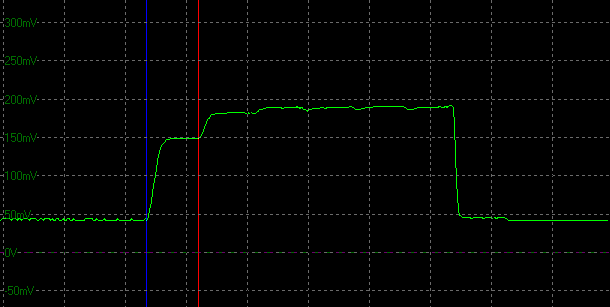
Transition: 0-50-0 (scale = 20ms)
@ 60Hz
If we take a closer look at an example transition
from 0-50 we can see why the rise times were particularly slow. The measured
19.3ms response time here (0-50) is because there seems to be a step in the
brightness curve as it tries to reach the desired brightness level (50). As a
reminder, the lower flat line represents the darker shade of the transitions
(0), and the upper flat(ish) line represents the lighter shade of the transition
(50). It seems that the brightness only reaches part of the way towards the
required level, and has a defined "step" before it then changes brightness again
to reach the desired level. If you look at that time it takes for the step to
complete, before the brightness starts to increase again up towards the desired
level, it is 16.667ms, which equates to 1 frame at 60Hz refresh rate. This is
the cause for the slow rise times here. On the other hand, the fall time from
50-0 is very fast indeed, measuring only 1.1ms. There is no apparent 'stepping'
of the brightness curve in this example. We've seen this same behaviour on other
modern TN Film panels like the
BenQ XL2720Z and
Asus ROG Swift PG278Q.

With overdrive now switched up to the 'Faster'
mode, response times had improved quite nicely, with an average now of 7.2ms G2G
measured. There was still no overshoot at all, so there seemed to be no
side-effects to using this mode. Some of the slower rise times had been sped up
now, although some changes to the brighter shades were still quite slow. Rise
times on average were slower (10.8ms) than fall times (3.6ms). This was
definitely a marked improvement in response times though over the 'standard'
mode, confirmed also with subjective observations as well.

The final 'Fastest' overdrive setting boosted the
response times quite a lot further. We now had a very impressive G2G response
time average of only 2.4ms. Some transitions reached down to the advertised 1ms
G2G even which means the screen is capable of living up to its spec. However,
some significant overshoot was introduced on most transitions which was very
noticeable in practice. This level of overshoot is far too much and makes this
mode unusable. Stick with the 'faster' mode for the optimum balance.
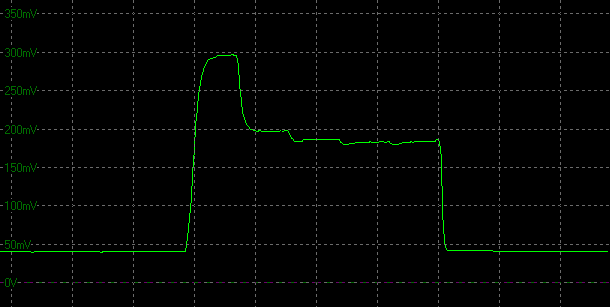
Transition: 0-50-0 (scale = 20ms)
@ 60Hz
An example of the overshoot is shown above
(79.3%).
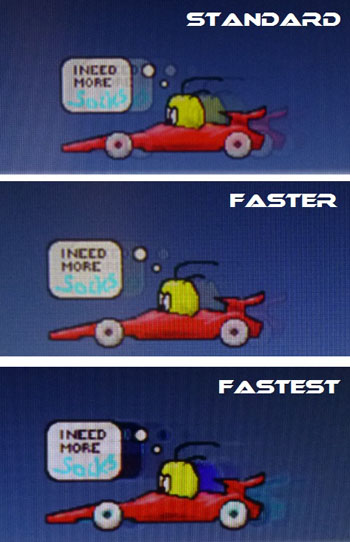
If we take some test photos using the PixPerAn
tool you can make some further visual comparisons between the overdrive
settings. With overdrive off the slow response times lead to a pronounced blur
to the moving image in practice which you can easily see. Turning the setting up
to Standard brings some improvement in visual appearance. The blur is reduced
noticeably and the moving image becomes sharper. The response times aren't as
fast as we have seen from some TN Film panels so blurring is a little more
apparent, but there is no overshoot evident at all so no trade-off is needed
when using this mode. The 'fastest' mode shows a very obvious dark and pale
trail because of the overshoot of the response times and should be avoided.
More Detailed Measurements - Overdrive = Faster
Having established that the Response Time 'Faster' mode seemed to
offer the best response/overshoot balance we carried
out our normal wider range of measurements as shown below:
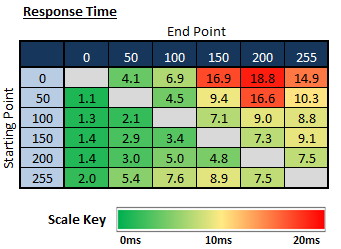
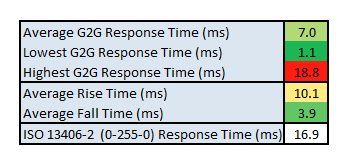
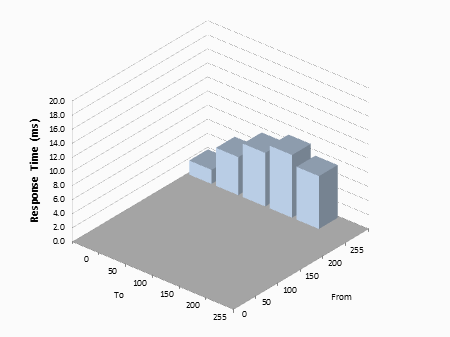
The average G2G response time was more accurately
measured at 7.0ms which was pretty good overall. Some transitions were as fast as
1.1ms, pretty much meaning it lives up to its spec. However, it is the average
G2G figures which you need to consider here. Rise times were notably slower than
fall times with a 10.1ms average. A few particularly troublesome transitions
were to blame for some of this, where response time was slow (e.g. 0-200 =
18.8ms).
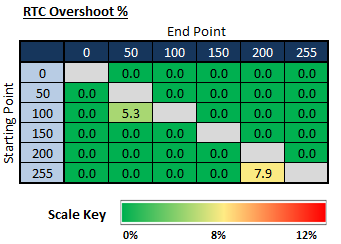
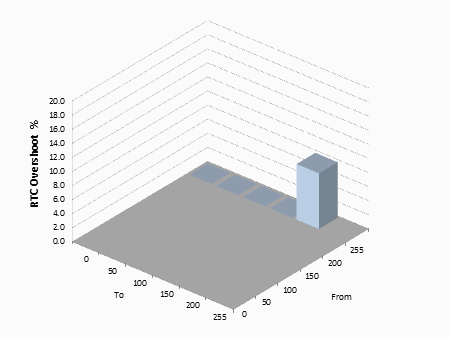
There was pretty much no overshoot as well in this
overdrive mode, with only a couple of transitions showing anything at all, and
even then, very low.
The overdrive impulse was being applied well and in a controlled fashion which was pleasing.

Display Comparisons
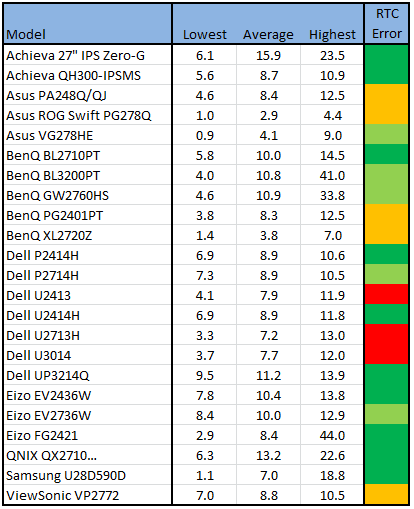
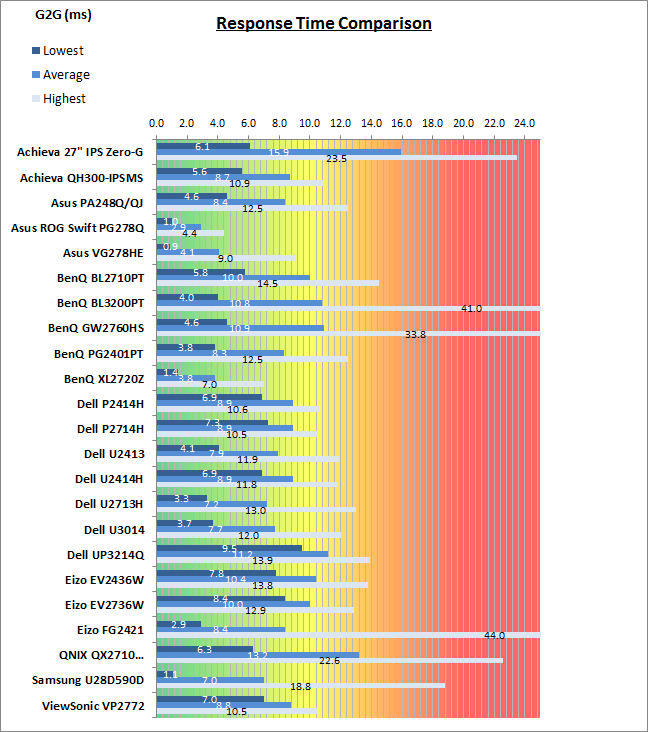
The above comparison table and graph shows you the
lowest, average and highest G2G response time measurement for each screen we
have tested with our oscilloscope system. There is also a colour coded mark next
to each screen in the table to indicate the RTC overshoot error, as the response
time figure alone doesn't tell the whole story.
The response time performance of the U28D590D was
decent overall, but a little slow really for a modern TN Film panel. With an
average G2G response time of 7.0ms, it fell behind gaming models like the Asus
ROG Swift PG278Q (2.9ms) and BenQ XL2720Z (3.8ms) by a fair amount. The slower
rise times on the Samsung were to blame here, as fall times were very fast.
There was basically no overshoot on the Samsung though, whereas some minor
issues were introduced on the BenQ and Asus models where the overdrive impulse
is more aggressive to squeeze more out of the response times.
Despite not being as fast as some higher end
gaming displays, the response times were still a bit faster than the best IPS
models. Screens like the Dell U2414H and P2414H (both 8.9ms G2G average)
represent about as fast as you can get from a modern IPS-type panel, without
introducing lots of nasty overshoot. The Samsung felt faster in practice as well
and TN Film technology is generally a better choice for gaming.
The screen was also tested using the chase test in
PixPerAn for the following display comparisons. As a reminder, a series of
pictures are taken on the highest shutter speed and compared, with the best case
example shown on the left, and worst case example on the right. This should only
be used as a rough guide to comparative responsiveness but is handy for a
comparison between different screens and technologies as well as a means to
compare those screens we tested before the introduction of our oscilloscope
method.

28"
1ms
G2G Innolux TN Film (Overdrive = Faster)
In practice the Samsung U28D590D performed best with
the Overdrive setting on 'Faster'. There was still some low levels of blurring
to the moving image but nothing too noticeable. Thankfully there was very no
overshoot introduced in this mode which was excellent.

28"
1ms
G2G Innolux TN Film (Overdrive = Faster)

27" 4ms G2G AU
Optronics AHVA (AMA Setting = High)

27" 8ms G2G
LG.Display AH-IPS

27" 5ms G2G
Samsung PLS (Trace Free = 40)

27" 12ms G2G
Samsung PLS (Response Time = Advanced)
Firstly it is interesting to compare the U28D590D to some of the popular 27"
models we have tested with 2560 x 1440 resolutions and IPS-type panels (IPS, PLS
and AHVA). You can
see first of all a comparison against the
BenQ BL2710PT which shows a quite comparable performance to the Samsung in
these tests, with slightly higher levels of blur and no overshoot issues. The
Dell U2713HM was
a bit faster than the BenQ and eliminated
a lot of the visible blurring, but also remained free from overshoot which was
a bonus. It was very close really to the Samsung in responsiveness. The
Asus PB278Q was again
similar, and although it showed a little dark overshoot it was very slight. The
ViewSonic VP2770-LED was more comparable to the Samsung in visible blurring
as well.

28"
1ms
G2G Innolux TN Film (Overdrive = Faster)

27"
1ms
G2G AU Optronics TN Film @ 144Hz (OD = Normal)

27" 1ms G2G
AU Optronics TN Film + 144Hz (AMA = High)

23.5" 4ms G2G
Sharp MVA + 120Hz
We've also included a comparison above against
3 very fast 120Hz+ compatible screens we have tested. The other screens shown
here are all aimed primarily at gamers and have various features and extras
which make them more suitable overall for gaming.
Firstly there is a comparison against the
Asus ROG Swift PG278Q with its 144Hz refresh
rate and fast response time TN Film panel. This showed very fast pixel response times and smooth movement thanks to
its increased refresh rate. You are able to reduce the motion blur even more
through the use of the ULMB strobed backlight as well if you need to. In other
related areas this screen also supports NVIDIA's G-sync technology. There was
some slight overshoot noticeable on the Asus but nothing major.
Then there is a comparison against the
BenQ XL2720Z with another very fast TN Film panel and 144Hz refresh rate.
This showed very low levels of motion blur, but some dark overshoot was
introduced as a side-effect as you can see. This screen even includes a native
Blur Reduction mode to help eliminate further perceived motion blur.
Lastly there is the MVA based Eizo FG2421 screen
with a fast response time (especially for the panel technology being used) and
120Hz refresh rate support. There is also an additional 'Turbo 240' motion blur
reduction mode which really helps reduce the perceived motion blur in practice.
While these pixel response tests from PixPerAn
give one view of the performance of the panel, there is something else going on as well here which can't be picked out by the camera. All of these other
gaming models are
running at 120Hz (or higher) refresh rates, which allows for improved 120fps+ frame rates and
in some cases the support of
3D stereoscopic content as well. This can really help improve smoothness and
the overall gaming experience so these screens still have the edge when it comes
to fast gaming. Any additional extras to reduce perceived motion blur can also
have a real benefit in practical terms, and again not easy to pick out with this
camera method.

The overall gaming performance of the Samsung
U28D590D was decent enough overall. Response times were not as fast as some
gaming TN Film panels but they were certainly more than adequate, and freedom
from any overshoot issues was a big bonus. The screen can support 60Hz refresh
rate over DisplayPort which is excellent, as some screens are limited to 30Hz
which could really be a problem in games.
Important 4k Consideration - one big
consideration you need to make is that the 3840 x 2160 resolution is likely to
be a major drag on even high end graphics cards and PC systems when it comes to
gaming. You really need to think about the type of game you want to play, the
settings you want to use, and whether your system can handle outputting such a
high resolution effectively. Don't forget that many gaming titles don't support
this resolution either, so that could be another issue. Those that do can
present further problems as well when it comes to the user interface as lack of
scaling results in tiny text or hard to read maps etc. One option of course is
to run the game at a lower resolution and let the screen scale it. That's
probably the most sensible option in most cases but kind of defeats the point of
having a 4k resolution in the first place. If you have games which can natively
support this resolution properly, they would look fantastic given the very high
resolution and small pixels.
If gaming is really your priority you may want to consider some of the more gamer orientated 120Hz+, TN Film
based compatible displays out
there, or perhaps something like the Eizo FG2421. Even better still would be models equipped with
LightBoost systems or other motion blur reduction backlights for optimum
motion blur elimination.

Additional Gaming Features
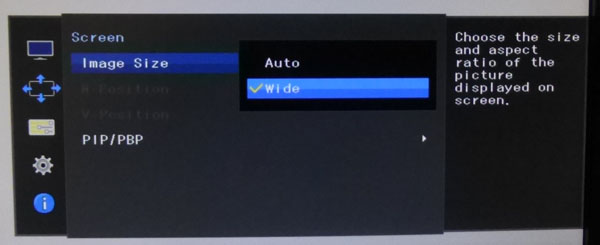
Aspect Ratio Control -
The U28D590D has two options for
aspect ratio control through the OSD 'screen' menu, using
the 'image size' option. There are options for 'auto' and 'wide'. Auto will
maintain the aspect ratio of the source, although it doesn't do 1:1 pixel
mapping and instead stretches the image to fill as much of the screen as
possible. The wide option will stretch the source content to fill the screen in
a 16:9 format no matter what its native aspect is.
Preset Modes -
There is a specific 'game mode' available in the
OSD which just seems to over-saturate and over-sharpen the image.

Lag
We have written an in depth article about
input lag and the various measurement techniques which are used to evaluate
this aspect of a display. It's important to first of all understand the
different methods available and also what this lag means to you as an end-user.
Input Lag vs. Display Lag vs. Signal
Processing
To avoid confusion with different terminology we
will refer to this section of our reviews as just "lag" from now on, as there
are a few different aspects to consider, and different interpretations of the
term "input lag". We will consider the following points here as much as
possible. The overall "display lag" is the first, that being the delay between
the image being shown on the TFT display and that being shown on a CRT. This is
what many people will know as input lag and originally was the measure made to
explain why the image is a little behind when using a CRT. The older stopwatch
based methods were the common way to measure this in the past, but through
advanced studies have been shown to be quite inaccurate. As a result, more
advanced tools like SMTT provide a method to measure that delay between a TFT
and CRT while removing the inaccuracies of older stopwatch methods.
In reality that lag / delay is caused by a
combination of two things - the signal processing delay caused by the TFT
electronics / scaler, and the response time of the pixels themselves. Most
"input lag" measurements over the years have always been based on the overall
display lag (signal processing + response time) and indeed the SMTT tool is
based on this visual difference between a CRT and TFT and so measures the
overall display lag. In practice the signal processing is the element which
gives the feel of lag to the user, and the response time of course can
impact blurring, and overall image quality in moving scenes. As people become
more aware of lag as a possible issue, we are of course keen to try and
understand the split between the two as much as possible to give a complete
picture.
The signal processing element within that is quite
hard to identify without extremely high end equipment and very complicated
methods. In fact the studies by Thomas Thiemann which really kicked this whole
thing off were based on equipment worth >100,1000 Euro, requiring extremely high
bandwidths and very complicated methods to trigger the correct behaviour and
accurately measure the signal processing on its own. Other techniques which are
being used since are not conducted by Thomas (he is a freelance writer) or based
on this equipment or technique, and may also be subject to other errors or
inaccuracies based on our conversations with him since. It's very hard as a
result to produce a technique which will measure just the signal processing on
its own unfortunately. Many measurement techniques are also not explained and so
it is important to try and get a picture from various sources if possible to
make an informed judgement about a display overall.
For our tests we will continue to use the SMTT
tool to measure the overall "display lag". From there we can use our
oscilloscope system to measure the response time across a wide range of grey to
grey (G2G) transitions as recorded in our
response time
tests. Since SMTT will not include the full response time within its
measurements, after speaking with Thomas further about the situation we will
subtract half of the average G2G response time from the total display lag. This should allow us to give a good estimation of
how much of the overall lag is attributable to the signal processing element on
its own.
Lag Classification
To help in this section we will also introduce a broader classification system
for these results to help categorise each screen as one of the following levels:
-
Class 1)
Less than 16ms / 1 frame lag - should be fine for gamers, even at high levels
-
Class
2)
A lag of 16 -
32ms / One to two frames - moderate lag but should be fine for many gamers.
Caution advised for serious gaming and FPS
-
Class
3)
A lag of more
than 32ms / more than 2 frames - Some noticeable lag in daily usage, not
suitable for high end gaming

For the full reviews of the models compared here and the dates they were written
(and when screens were approximately released to the market), please see our
full
reviews index.
|
(Measurements in ms) |
User Mode |
|
Total Display Lag (SMTT
2) |
39.0 |
|
Pixel Response Time
Element |
3.5 |
|
Estimated Signal
Processing Lag |
35.5 |
|
Lag Classification |
3 |
|

Class
3 |
We have provided a comparison above against other
models we have tested to give an indication between screens. The screens
tested are split into two measurements which are
based on our overall display lag tests (using SMTT) and half the average G2G
response time, as measured by the oscilloscope. The response time is split from
the overall display lag and shown on the graph as the green bar. From there, the
signal processing (red bar) can be provided as a good estimation.
The screen showed a total average display lag of
39.0 ms as measured with SMTT 2. Taking into account half the average G2G
response time at 3.5ms, we can estimate that there is ~35.5 ms of signal
processing lag on this screen. This is high and could present problems for
anyone sensitive to lag, or playing fast FPS games.

Movies and Video

The following summarises the screens performance
in video applications:
-
28"
screen size makes it a reasonable option for an all-in-one multimedia screen,
but being quite a bit smaller than most modern LCD TV's of course.
-
16:9
aspect ratio is more well suited to videos than a 16:10 format screen, leaving
smaller borders on DVD's and wide screen content at the top and bottom.
-
3840 x
2160 resolution can support full 1080 HD resolution content. It can also
support 4k content.
-
Digital interface support HDCP for any encrypted and protected content
-
2x HDMI and DisplayPort
connections available. Nice to see 2x HDMI connectivity included for modern DVD
players, Blu-ray, consoles etc.
-
Cables provided in the box
for (x1) HDMI and DisplayPort.
-
Moderate AG coating provides reasonably clear images with no major graininess,
and without the unwanted reflections of a glossy solution. Some graininess
apparent as with other TN Film panels, but shouldn't present a problem in
movies.
-
Wide
brightness range adjustment possible from the display, including high maximum
luminance of ~362
cd/m2 and an excellent minimum
luminance of 14 cd/m2. This should afford you very good control for different
lighting conditions. Contrast ratio remains stable across that adjustment
range as well and is reasonable for a TN Film panel. Brightness regulation is controlled
without the need for PWM and so is flicker free between settings of 100 and
31% brightness, allowing you to reach down to ~158 cd/m2 before you
need to enter the PWM-zone. For very low lighting conditions the use of a low
frequency 240Hz PWM below 30% brightness may present some problems.
-
Black
depth and contrast ratio are reasonable for a TN Film panel at 797:1 after
calibration. Detail in darker scenes should not be lost as a result.
-
There
is no specific 'movie' preset mode available for movies or video.
-
Good
pixel responsiveness which can handle fast moving scenes in movies without
issue. No real overshoot issues which is good news.
-
Viewing angles are limited due to the use of TN Film panel technology. May
cause issues with gamma and contrast shift if you change your line of sight or
have several people trying to see the screen at once. Not really an ideal
technology for movies as a result of this viewing angle limitation.
-
No noticeable backlight leakage which is good, even in darkened room
conditions.
-
Very limited range of ergonomic adjustments
available from the stand, with only a basic and stiff tilt adjustment offered.
May present problems when viewing the screen from different positions.
-
No
integrated stereo speakers on this model, but there is an audio out jack if
sending sound to the screen over HDMI.
-
Decent
enough range of
hardware aspect ratio options available which is very useful for external
devices.
-
Picture in picture (PiP) and Picture By Picture (PbP) are available on
this model.

Conclusion
The Samsung U28D590D was an interesting first test
for us of one of the new 28" 4k screens on the market. It's clear to see why
these relatively affordable screens are attracting a lot of interest as the jump
in resolution and support for 4k content is a big selling point and a
significant evolution in the monitor market. The U28D590D is a good option
compared with a lot of its competition since it has an attractive design, decent
input options, is detected as a single screen (not using MST) and supports 60Hz
refresh rate which in our view is vital. The screen offered a decent enough
default setup, reasonable contrast ratio and pretty fast response times which
were pleasing. Of course, the screen is limited in some areas by its TN Film
panel technology, a measure required at the moment to allow retail costs to be
as low as they are. Viewing angles remain a noticeable weakness of the
technology of course. We were disappointed by the high lag of this screen as
well, as although response times were pretty decent, this could be a bit of an
issue for competitive gaming.
Samsung could have done better with the stand we
felt, as it was very limited, stiff and the screen was wobbly. VESA support
would have been nice too. The screen does feel a bit no-frills as well, as
there's no extra USB ports or anything. There are at least some decent
connectivity options, the design is nice, and the joystick control for the OSD
is a nice touch. The PWM-free backlight between 100 and 31% brightness was
pleasing, but it was a shame that you could not reach low enough luminance
without needing to enter the PWM-zone below that. It might have been better to
have a completely PWM-free backlight for all adjustments.
We were left unconvinced by the 4k resolution
though if we're honest. That kind of resolution is just too high by default on
many systems on a screen
this size for day to day work. If you've got an actual requirement for 4k
support for video, imaging or high resolution work (CAD/CAM) then it is of
course very impressive. The detail and sharpness provided is excellent. If
you're wanting to use it for normal day to day uses though the pixel pitch is
tiny and really fonts become too hard to see. Make sure you understand the
limitations of 4k as opposed to assuming that bigger is better, but if you do
decide you want a well-priced 4k display, this is a decent choice on the most
part.
If you appreciate the review
and enjoy reading and like our work, we would welcome a
donation
to the site to help us continue to make quality and detailed reviews for you.
|
Pros |
Cons |
|
Low cost screen offering 4k
resolution |
4k resolution arguably too
high for this size screen for some uses and systems |
|
Decent response times from TN
Film panel and support for 60Hz refresh rate |
PWM used for lower brightness
adjustment range |
|
Decent enough default setup |
Limited stand adjustments |

Support TFTCentral,
buy the Samsung U28D590D using our affiliate link